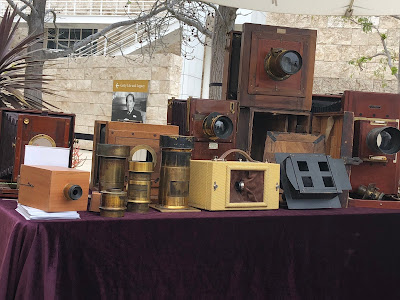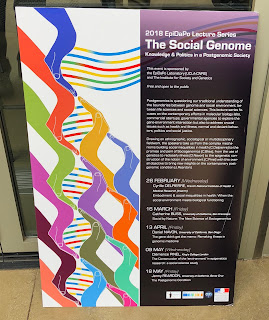Event 1: Paper and Light
On April 7th, I went to photographer Luther Gerlach’s “Paper and Light” lecture at the Getty Center. He mainly examined the art and science behind 19th-century photography, as well as the evolution of photographic technology throughout time.
 |
| Gerlach's personal collection of cameras and lenses |
He first started introducing a variety of the early 1800s photographic materials, such as the lenses and large-format cameras. One specific example he gave was the “camera obscura,” which was a Latin name for the camera in a darkened chamber (Gerlach, 2018). He also shared with us that camera lenses do not produce an upright image but rather an inverted “real image” of the object, as shown in figure 1.2, which resonated with what I have learned in physics class. The reason why we don’t see an upside-down photo in the camera is that our brains correct it. Then, when you move closer to the focal point or zooming in, you can see a larger inverted real image as shown in figure 1.3 (Michigan State University, n.d.).
Gerlach then discussed the processes of making the photographs. One of the earliest techniques involved the use of silver nitrate where some parts of the photograph darkened in exposure to light. This process required an extremely long exposure — around eight hours and the picture faded after a while (Boyd, 2010). Then, as science and technology evolved, they discovered the use of Bromine which catalyzed the picture’s sensitivity to light a lot faster so by then, the entire process took only a minute or so (National Portrait Gallery, n.d.).
 Overall, I thought that Gerlach’s lecture was very fascinating and educational to me personally because I have always been interested in both physics and photography. I got to learn all of these optics and refractions but I never quite understand how to apply them to real-life situations until now. I would recommend this event to those who are passionate about photography or just want to have a better selfie-taking skill because Gerlach also taught you some tips on how to edit those photos on Instagram!
Overall, I thought that Gerlach’s lecture was very fascinating and educational to me personally because I have always been interested in both physics and photography. I got to learn all of these optics and refractions but I never quite understand how to apply them to real-life situations until now. I would recommend this event to those who are passionate about photography or just want to have a better selfie-taking skill because Gerlach also taught you some tips on how to edit those photos on Instagram!
His lecture was relevant to our class because he explored how science can play a role in capturing art at its essence. Moreover, I think photography is the perfect proof of how art and science are very much interdependent (Snow, 1959). Without one or the other, photography would not come about the way it did.
 |
| Gerlach and the photo that he took |
 |
| Me with the red-box camera |
Work Cited
Boyd, Jane. "Silver and Sunlight." Science History Institute. 2010. Retrieved from https://www.sciencehistory.org/distillations/magazine/silver-and-sunlight
Gerlach, Luther. “Paper and Light.” Artist at Work, 7 April 2018, The Getty Center, Los Angeles, CA. Retrieved from www.getty.edu/museum/programs/courses/demos.html
Michigan State University. "Real, Image and Virtual."Retrieved from https://web.pa.msu.edu/courses/2000fall/PHY232/lectures/lenses/images.html
National Portrait Gallery. "Bromide Print." Retrieved from https://www.npg.org.uk/collections/explore/glossary-of-art-terms/bromide-print
Snow, Charles. The Two Cultures and the Scientific Revolution. New York: Cambridge UP, 1959. Print.




Comments
Post a Comment